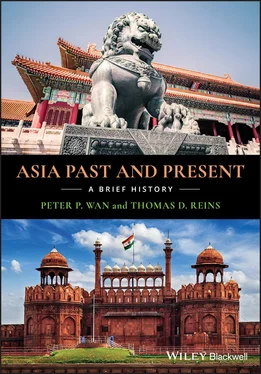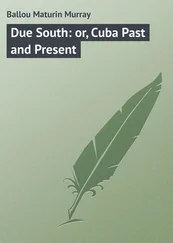The Age of the Kings and Emperors (Seventh–Twelfth Centuries)
The Japanese have a “creation myth” just like other civilizations. In their mythology, the Japanese people (the Yamato people) are descended from the Sun Goddess Amaterasu and her brother‐husband. Traditional Japanese historiography claims that Emperor Jimmu founded the State of Japan in 660 BCE. Verifiable history puts the appearance of the first Japanese state on the Yamato Plain at the seventh century BCE. The earliest reliable information on early Japanese life is found in post–Han Dynasty Chinese sources. They describe Japan as an agricultural society made up of clans that are in transition from matriarchal to patriarchal society; the clans control territories and are headed by a man or woman who combines the functions of chieftain and high priest, and the Yamato clan dominates the various other clans.
The indigenous religion of Japan is Shinto, the “Way of the Gods.” It celebrates the kamis , who are nature spirits who dwell in unique natural objects, such as a magnificent mountain, a gnarled tree, or a clear creek. Shinto has simple rituals, a cheerful spirit, exuberant holidays, and an emphasis on cleanliness. It has no sacred scripts, doctrinal demands, or theoretical elaborations. Its simplicity may explain its staying power.
The Yamato clan gradually developed a Yamato State on the Chinese model replete with a ruler called the “great king,” a royal court, and a centralized administrative structure, but it had no permanent capital. The “great king” was a military overlord who dominated over the regional lords, and held land and granaries throughout the country. He allowed those clans that yielded to his authority to maintain local autonomy, appointed their chiefs to serve as officials at his court, and placed their gods in a pantheon of gods with the Yamato Sun Goddess at its pinnacle. He ruled over a hierarchic sociopolitical structure that included regional lords, peasants, craftsmen, and slaves. A warrior class dominated the commoners. Over time, the Yamato kings extended their rule over the entire land, and the “Yamato” name came to stand for all of Japan.
Chinese culture and Buddhism reached Japan via Korea in the fifth and sixth centuries. Prince Shotoku (574–622) promoted cultural exchange with China. He sent regular missions to China composed of students, Buddhist monks, merchants, and government officials to study and learn, and they returned to inform the Japanese of Chinese culture. He officially embraced Chinese culture with the promulgation of the Seventeen‐Article Constitution of 604, whose purpose was to establish a Chinese‐style government to strengthen the position of the “great king,” and he urged conversion to Buddhism. Later, the Taika Reforms in 646, introduced by Emperor Kotoku, created institutional reforms to transform Japan based on the Chinese political model. Significantly, he changed his title from “great king” to “emperor,” and rewarded his supporters with titles and positions in a government bureaucracy. The Japanese built their first real city, Nara, on the model of Tang China’s capital Chang’an in 710. Japanese emperors would rule from their capitals at Nara and nearby Heian for the next 600 years.
The Nara period was a time of wholesale cultural borrowing from China. The emperor even tried to adopt China’s “equal fields system,” but abandoned the attempt when he found it to be too complex to maintain. Instead, he decided it would be easier to set tax quotas for the provinces, and delegate the power of tax collection to provincial officials. In the actual execution of the system, however, greedy officials at each level would collect more than the set quota and pocket the difference. This put the cultivators at the mercy of the grasping officials. The system was made worse when the emperor granted the imperial family, aristocrats, and monasteries exemption from taxes and government jurisdiction. Local lords saw a loophole in the exemptions. They would formally sign the ownership of their land over to a privileged individual in the royal court, and then nominally pay a small rent for the right to use the same piece of land, and thus be exempted from taxes and government control. Small cultivators followed suit; they gave up title of ownership to tax‐exempt local lords and powerful institutions, thus freeing themselves from the arbitrary control of local government. But the system had unintended consequences: (1) It created a class of absentee landowners, who would hire local “stewards” to manage their lands; and (2) this new arrangement reduced large numbers of free peasants to serfdom.
Large landholders were essentially tax‐exempt under this system. Powerful men at the royal court became titleholders of lands they did not honestly own, manage, or cultivate, but they benefitted from it by collecting small but steady payments in rent. The peasants, who were the original owners and cultivators of the land, were now tenants or serfs—but even they were glad to be beyond the reach of the government officials. The ultimate loser was the emperor and government, for they had lost control of a good portion of their tax base.
This intricate system of land ownership and taxation is a good example of the unique multilayered structures of Japanese society: The titleholder of the land was neither the true owner nor the cultivator, and the true owner and cultivator wasn’t the titleholder.
The emperor also decided that the Chinese system of a recruited army was too expensive and inefficient. So he organized locally recruited mounted warriors, whose function was to collect taxes and maintain local law and order. These were men of means, for only they could afford to undergo the long years of training and purchase their horses, armor, and weapons. They soon became an elite class of professional warriors or bushi , also called samurai from the Japanese verb saburai , “to serve.” These warriors served their higher, liege lord and ultimately, in theory, the emperor. Local government officials, stewards, and an occasional aristocrat would follow the emperor’s example and hire their own samurai. A strong personal bond existed between a local lord and his samurai, for the lord gave his samurai land or a salary, and a samurai in return pledged his loyalty to the lord.
The samurai developed a code of conduct, called bushido or the “way of the warrior.” It is an amalgam of traditional Japanese warrior ethic, Chinese Confucianism, and Zen Buddhism. It emphasizes discipline, austerity, loyalty, and self‐sacrifice. The cherry blossom came to symbolize the samurai, for a parallel was seen between the cherry blossom in its vitality and fiery burst of color in springtime and the brief and violent life of a samurai. A true samurai accepted a valiant life and an early death as the honorable norm.
The aristocratic Fujiwara family lent their name to an exquisite and sophisticated Fujiwara culture that dominated Japan’s high society in the Heian period. Fujiwara Michinaga (966–1028) dominated the royal court for 30 years, as the father of four empresses, the grandfather of three emperors, and the uncle of two emperors. He was wealthy and powerful, and he was learned in history, poetry, literature, music, and Buddhism. These qualities made him the embodiment of Fujiwara culture, in which birth, rank, and breeding were everything, and the focus was on the pleasures of leisure and beauty.
The Tale of Genji (ca. 1010) is a long novel about life in Heian Japan. It is variously called the world’s first modern novel, the first psychological novel, or a historical novel. Its author, Murasaki Shikibu, was born to a minor noble Fujiwara family, and her father served in the imperial court as a scholar‐official. Recognizing her talents, her erudite father decided to teach her classical Chinese literature and poetry and kanji, all of which were traditionally reserved for the education of men. She grew up to become a lady‐in‐waiting to Empress Shoshi, and had a front seat to observe Fujiwara’s culture up‐close.
Читать дальше












